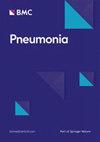Upper airway viruses and bacteria detection in clinical pneumonia in a population with high nasal colonisation do not relate to clinical signs
IF 8.5
Q1 RESPIRATORY SYSTEM
引用次数: 11
Abstract
Indigenous Australian children have high (up to 90%) rates of nasopharyngeal microbial colonisation and of hospitalisation for pneumonia. In Indigenous children hospitalised with pneumonia in Central Australia, we describe the nasopharyngeal detection of viruses and bacteria and assessed whether their presence related to signs of pneumonia (tachypnoea and/or chest in-drawing) on hospital admission and during subsequent days. Nasopharyngeal swabs (NPS) and data were prospectively collected from 145 children (median age = 23.5 months, interquartile range [IQR] 8.7–50) hospitalised with pneumonia at Alice Springs Hospital, Australia, between April 2001 and July 2002. The cohort was enrolled in a randomised controlled study using zinc and/or vitamin A supplementation. NPS were taken within 24 hours of hospitalisation and kept frozen at-80°C until analysed in 2014. Polymerase chain reaction (PCR) was used to detect Moraxella catarrhalis, Haemophilus influenzae, Streptococcus pneumoniae, Staphylococcus aureus, Chlamydophila pneumoniae, Mycoplasma pneumoniae, and 16 respiratory viruses. Uni- and multi-variate analyses were used to examine the relationships. One or more organisms were present in 137 (94.5%) NPS; 133 (91.7%) detected ≥ 1 bacterium, 34 (37.2%) for ≥ 1 virus and 50 (34.5%) were positive for both viruses and bacteria. C. pneumoniae (n = 3) and M. pneumoniae (n = 2) were rare. In multi-variate analyses, age < 12 months (odds ratio [OR] 6.6 [95% confidence interval {CI} 1.7–25.4]) and fever (OR 4.1 [95% CI 1.7–10.4]) were associated with tachypnoea and chest in-drawing. However the presence of bacteria and/or virus type was not associated with tachypnoea and/or chest in-drawing on admission or during recovery. In children with high nasopharyngeal microbial colonisation rates, the utility of NPS in determining the diagnosis of clinical pneumonia or duration of tachypnoea or in-drawing is likely limited. Larger cohort and case-control studies are required to confirm our findings.在高鼻定植人群中,临床肺炎的上呼吸道病毒和细菌检测与临床体征无关
澳大利亚土著儿童的鼻咽微生物定植率和肺炎住院率很高(高达90%)。在澳大利亚中部因肺炎住院的土著儿童中,我们描述了对病毒和细菌的鼻咽检测,并评估了它们的存在是否与入院时和随后几天的肺炎症状(呼吸急促和/或胸部收缩)有关。本研究前瞻性地收集了2001年4月至2002年7月期间在澳大利亚Alice Springs医院因肺炎住院的145名儿童(中位年龄= 23.5个月,四分位数间距[IQR] 8.7-50)的鼻咽拭子(NPS)和数据。该队列纳入了一项随机对照研究,使用锌和/或维生素a补充剂。NPS在住院24小时内服用,并在80°C下冷冻,直到2014年进行分析。采用聚合酶链反应(PCR)检测卡他莫拉菌、流感嗜血杆菌、肺炎链球菌、金黄色葡萄球菌、肺炎衣原体、肺炎支原体及16种呼吸道病毒。采用单变量和多变量分析来检验两者之间的关系。137个(94.5%)NPS中存在一种或多种生物;检出≥1种细菌133例(91.7%),检出≥1种病毒34例(37.2%),病毒和细菌双阳性50例(34.5%)。肺炎支原体(3例)和肺炎支原体(2例)少见。在多因素分析中,年龄< 12个月(比值比[OR] 6.6[95%可信区间{CI} 1.7-25.4])和发烧(比值比[OR] 4.1 [95% CI 1.7-10.4])与呼吸急促和胸腔内吸有关。然而,在入院或康复期间,细菌和/或病毒类型的存在与呼吸急促和/或胸腔吸积无关。在鼻咽微生物定植率高的儿童中,NPS在确定临床肺炎诊断或呼吸急促或吸入持续时间方面的作用可能有限。需要更大规模的队列研究和病例对照研究来证实我们的发现。
本文章由计算机程序翻译,如有差异,请以英文原文为准。
求助全文
约1分钟内获得全文
求助全文

 求助内容:
求助内容: 应助结果提醒方式:
应助结果提醒方式:


